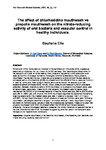The effect of chlorhexidine mouthwash vs propolis mouthwash on the nitrate-reducing activity of oral bacteria and vascular control in healthy individuals
| dc.contributor.author | Ellis, Stephanie | |
| dc.date.accessioned | 2021-07-08T21:10:57Z | |
| dc.date.available | 2021-07-08T21:10:57Z | |
| dc.date.issued | 2021 | |
| dc.identifier.citation |
Ellis, S. (2021) ‘The effect of chlorhexidine mouthwash vs propolis mouthwash on the nitrate-reducing activity of oral bacteria and vascular control in healthy individuals’, The Plymouth Student Scientist, 14(1), pp. 1-13. | en_US |
| dc.identifier.uri | http://hdl.handle.net/10026.1/17340 | |
| dc.description.abstract |
Nitrate and nitrite molecules are involved in the synthesis of nitric oxide (NO), a gaseous vasodilatory molecule, via the nitrate-nitrite-NO pathway. Oral bacteria are responsible for the reduction of nitrate to nitrite making them important regulators in NO production and vascular control. This paper aimed to investigate whether a laboratory-made propolis mouthwash maintained the oral nitrate reducing capacity (ONRC) of commensal bacteria compared with a chlorhexidine (CHX) mouthwash and the effects of this on vascular function in healthy individuals. Twenty-eight healthy participants visited the laboratory on two occasions where anthropometric, ONRC, blood pressure and vascular function data were collected. Between laboratory visits a CHX mouthwash or a propolis mouthwash were used for seven days, twice-daily. It was found that propolis mouthwash used for seven days maintained the ONRC of commensal bacteria in healthy individuals (pre; 343.4 ±251.8μM vs post; 331.9 ±225.1μM, p=0.71) and that CHX mouthwash significantly abolished this activity, lowering levels by 67.7% in seven days (pre; 399.7 ±356.4μM vs post; 129.1 ±171.3μM, p<0.001). No significant changes in blood pressure or vascular function were seen following mouthwash use despite bacterial changes. It is unclear whether these insignificant findings are down to methodological issues or external physiological pathways. It was concluded that propolis mouthwash and CHX mouthwash affect the ONRC of commensal bacteria differently. Propolis mouthwash seems to preserve the ONRC therefore is less detrimental to the oral microbiome than CHX mouthwash suggesting potential uses in dentistry and as a therapeutic for hypertensive individuals. | en_US |
| dc.language.iso | en | en_US |
| dc.publisher | University of Plymouth | en_US |
| dc.rights | Attribution 3.0 United States | * |
| dc.rights.uri | http://creativecommons.org/licenses/by/3.0/us/ | * |
| dc.subject | propolis mouthwash | en_US |
| dc.subject | chlorhexidine mouthwash | en_US |
| dc.subject | chlorhexidine | en_US |
| dc.subject | oral bacteria | en_US |
| dc.subject | oral nitrate reducing capacity | en_US |
| dc.subject | vascular control | en_US |
| dc.title | The effect of chlorhexidine mouthwash vs propolis mouthwash on the nitrate-reducing activity of oral bacteria and vascular control in healthy individuals | en_US |
| dc.type | Article | en_US |
| plymouth.issue | 1 | |
| plymouth.volume | 14 | |
| plymouth.journal | The Plymouth Student Scientist |



